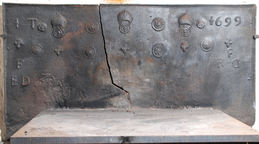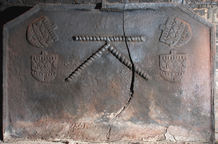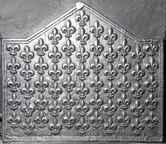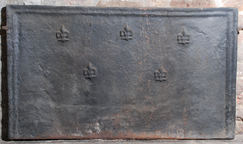-
1000
Description: Canted rectangle; stepped fillet edging (top and sides); straight twisted rope lengths parallel to top and parallel to each side, forming inner rectangle with rope quadrants across top corners; side compartments: line of 12 beads along top inside rope line, 3 semi-circular at corners, with a single bead in each corner quadrant, and 8 down each side; top centre, date with single bead above; cross with a cross stamp repeated 10 times to right of date and 9 time to left, one in each corner, and 13 down the left side and 12 down the right.
Notes: The quadrant arc and use of repeated beads suggests a common source with other firebacks of the same period.
Inscription: 1686
- Decoration tags:
- rectangular with canted top corners (shape)
- stepped fillet (edging)
- carved stamps
- individual numbers
- text
- objects
Manufactured: in 1686 in the Forest of Dean area of England.
Current location: Ashmolean Museum Broadway, 65 High Street, Broadway, Worcestershire, England.
(part of the Ashmolean Museum museum group)
- Attached to series:
- Newent area group
- Square cross Dean series 2
-
887
Description: Rectangular; stepped fillet edging (top and sides), ending short of bottom of plate; rose and crown stamp repeated three times across top of plate, with initials 'IT' followed by a rose stamp to left, and a rose stamp followed by the date to right (1 or I crossed in both cases); concentric roundel stamp between each pair of rose and crown stamps; lower down, five small inverted fleurs-de-lys between four concentric roundels; below left, initials FED in triad; below right, FRD in triad (D reversed).
Notes: An alleged connection with the Tichborne family who lived at Crippenden in Cowden, Kent, may be justified if the initials, IT, refer to John Tichborne, the last of his family in the village, who died in 1708. The identities of those whose initials form the two triads is not known. The style of rose and crown is similar to that used in gun founding in the Tudor period, suggesting that the furnace that was the source of this fireback may have been used for that purpose.
Inscription: IT 1699 / EFD [triad] RFD [triad]
- Decoration tags:
- rectangular (shape)
- stepped fillet (edging)
- carved stamps
- individual letters
- individual numbers
- heraldic
- text
- objects
Manufactured: in 1699 in the Weald area of England.
Current location: Crippenden Manor, Cowden, Kent, England.
- Attached to series:
- 1660s-90s Wealden series
- Fleur-de-lys firebacks
-
884
Description: Canted rectangle; stepped fillet edging (top and sides); twisted rope lengths parallel to top and parallel to each side, forming six compartments; side compartments: seven double fleurs-de-lys in vertical line; top corner compartments: one double fleur-de-lys angled parallel to canting; top compartment: date in centre, initials repeated at each end, three fleurs between date and initials, centre fleur perpendicular to others; main compartment: one fleur in each top corner, line of beads inside rope line, arc at corners.
Notes: The arc shape and use of repeated beads suggests a common source with other firebacks of the same period.
Inscription: RR / 1688 / RR
- Decoration tags:
- rectangular with canted top corners (shape)
- stepped fillet (edging)
- simple stamps
- carved stamps
- individual letters
- individual numbers
- heraldic
- text
- objects
Manufactured: in 1688 in the Forest of Dean area of England.
Current location: The George Hotel, Stone Street, Cranbrook, Kent, England.
- Attached to series:
- Newent area group
- Square cross Dean series 2
- Fleur-de-lys firebacks
-
871
Description: Canted rectanular shape, with stepped fillet edging (top and sides); upper centre, horizontal ?leather twist above an inverted ?leather twist 'V'; on each side, a shield-shaped stamp repeated twice, the upper one of each being angled so its side is parallel to the canted edging.
Notes: The design on the shield is not recognisably heraldic in form, and appears to incorporate a possible pictorial element although this is not clear; the inverted 'V' shape may have apotropaic significance.
Copies of this fireback are known.
- Decoration tags:
- rectangular with canted top corners (shape)
- stepped fillet (edging)
- simple stamps
- carved stamps
- apotropaic
- objects
Manufactured: in the late-16th century in England.
Current location: in private hands, East Grinstead, West Sussex, England.
Citation: Lloyd, N., 1925, 'Domestic Ironwork I', Architectural Review, 58, pp. 58-67.
- Attached to series:
- Miscellaneous stamp firebacks
-
88
Description: Rectangular with triangular arch; stepped fillet edging; eleven columns of fleurs de lys, maximum seven in column, but varied according to space, with fleurs alternated for spacing.
Notes: Whole pattern with five vertical planklines; a field of small fleurs de lys, France Ancient in royal heraldry, might suggest a continental origin.
Copies of this fireback are known.
- Decoration tags:
- rectangular with triangular arch (shape)
- stepped fillet (edging)
- whole carved pattern
- planklines
- heraldic
- objects
Manufactured: in the late-16th to early-17th century possibly in the Weald area of England.
Current location: Hampton Court, Richmond, Greater London, England.
- Attached to series:
- Miscellaneous royal firebacks
- Fleur-de-lys firebacks
-
150
Description: Rectangular with pentagonal arch; stepped fillet edging; six fleurs de lys - three in line at base of arch, two near top corners of rectangle, one in middle of rectanngle.
Notes: Other firebacks based on the same shape but with different edging suggests the use of a common base board, but with the edging and other decoration varied to order.
- Decoration tags:
- rectangular with five-facetted arch (shape)
- stepped fillet (edging)
- carved stamps
- heraldic
Manufactured: in the late-16th century in the Weald area of England.
Current location: Hastings Museum and Art Gallery, John's Place, Bohemia Road, Hastings, East Sussex, England.
Museum number: HASMG: 1908.175 (part of the Hastings Museum museum group)
- Attached to series:
- Miscellaneous stamp firebacks
-
592
Description: Flattened arched rectangular shape with rebated concave shoulders; double fillet edging; 11 x 9 grid portcullis with symmetrical chains in ‘S’ arrangement ending in a ring, from top corners, surmounted by an arched royal crown.
Notes: Whole pattern; the portcullis has a realistic, rather than symbolic, appearance.
Copies of this fireback are known.
- Decoration tags:
- rectangular with canted top corners and round arch (shape)
- stepped fillet (edging)
- whole carved pattern
- heraldic
- pictorial
- objects
Manufactured: in the late-16th to early-17th century in England.
Current location: Ham House, Richmond, Surrey, England.
Museum number: 1140112 (part of the National Trust museum group)
- Attached to series:
- Miscellaneous royal firebacks
-
658
Description: Canted rectangular shape; stepped fillet edging; indistinct pictorial scene of two men on the prow of a sailing ship, their arms in the air, passing a naked figure, arms also in the air.
Notes: Possibly a representation of Odysseus and one of the Sirens.
- Decoration tags:
- rectangular with canted top corners (shape)
- stepped fillet (edging)
- whole carved pattern
- pictorial
- mythological
- humans
Manufactured: in the early-18th century in France.
Current location: in private hands, Rolvenden, Kent, England.
- Attached to series:
- Miscellaneous pattern firebacks
-
1044
Description: Arched rectangular shape with sloped spandrels; stepped fillet-moulded edging; pictorial scene of a behatted woman and a girl standing behind a kneeling cloaked figure of a man wearing a pointed cap and holding an open book, with a cross above it; to the left a cottage with trees and ground; to the right the frame of a building.
Notes: The scene is entitled 'Frère Luce', copied from an engraving by Nicolas Larmessin III (1656-1725), of a painting (now lost) by Nicolas Vleughels (1668-1737), from 'Suites d'Estampes Nouvelles pour les Contes de La Fontaine' (c.1736-43).
Copies of this fireback are known.
- Decoration tags:
- rectangular with round arch (shape)
- stepped fillet (edging)
- whole carved pattern
- pictorial
- humans
- plants
- objects
Manufactured: in the mid- to late-18th century in France.
Current location: in private hands, not known.
Citation: Carpentier, H., 1912, Plaques de Cheminées (Paris, published by the author).
- Attached to series:
- Miscellaneous pattern firebacks
-
830
Description: Rectangular; stepped fillet moulded edging (top and sides); small fleur-de-lys stamp repeated five times, three centred across the top, two centred across the middle.
Notes: The fleur-de-lys stamp appears to have been constructed using wire.
- Decoration tags:
- rectangular (shape)
- stepped fillet (edging)
- carved stamps
- heraldic
- objects
Manufactured: in the mid- to late-16th century in the Weald area of England.
Current location: in private hands, Iford, East Sussex, England.
- Attached to series:
- Fleur-de-lys firebacks









